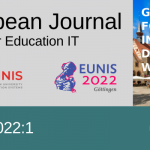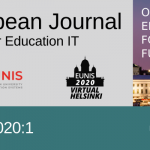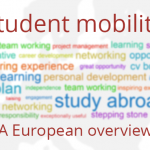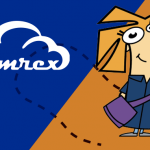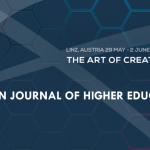
I few weeks ago, I had the chance to participate to Educause. Great place, great event, great talks but difficult to meet colleagues in such a huge attendance. As usual one is lost in the gigantic exhibition hall, navigating among the vendors and all their inventive proposals. As usual it was difficult to choose among the parallel conferences. Hopefully I was not alone, coming with ten colleagues from different French universities. We will soon write together a report on our findings and impressions. Hopefully it will be translated into English and made available to the EUNIS community.
Among many other thoughts, this week, I will discuss a very promising feature appearing at the horizon of the digital pedagogy: adaptive learning. A new generation of Learning Management Systems (LMS) is just emerging which goes much further in the implementation of a personalized education. We already had some highlights at EUNIS 2015, in Dundee, and now we have returns from colleagues in the US.
The emergence of MOOC has put in the forefront an important feature of all LMS, known and used only by the most advanced teachers, but ignored by the majority of their colleagues: the ability to guide the students through the course’s documents, building an educational paths. This goes far beyond providing a simple table of contents to search among the documents stored in the platform.
Most often platformsare used to store course materials and to provide links to documents available on the Web. In the best case,professors add a table of contents with links to each document so that students are not lost. However, it is possible to go further and to control the order in which students travel between the documents, instead of letting them peck at random. This is fundamental to help the students to gradually discover a subject, which requires the knowledge of some fundamentals before pursuing the discovery and the understanding of their course. All LMS allow, to some extent, to control the progressionby placing mandatory prerequisites before accessing a document, for instance having opened previous documents or successfully submitting a quiz or actively participating in a forum… This obviously complicates the construction of the course because,instead of a linear progression, one must prepare in advance all the control points to drive the students. Instructional designers are often essential to help teachers who are new to this approach. It also requires writing additional documents and the total workload is much larger than in the classical approach of teaching. This partly explains the lack of awareness of these LMS’ features by most teachers: they do not have the time and/or the training to build such complex courses. Building controlled pedagogic paths is certainly a progress, smarter than the usual linear progression, but it presents some limitations: the possible paths are provided in advance and cannot be adapted to each student.
An answer to this challenge is now emerging: adaptive learning.
Adaptive learning is supported by a new generation of LMS, enabling to dynamically create individualized learning paths for each student. A branch of the possible pathways is dynamically opened to a student, according to a number of criteria much larger and more sophisticated than those previously mentioned. These criteria are based on the mass of data collected by the platform, knowledge acquired when running the course, on a set of parameters based on the use of the platform by the students and the individual dynamic profile of each user. Each branch of the graph is analyzed and the least employed are dismissed. The goal is to build a predictive and adaptive model that employs methods of Artificial Intelligence. Teachers can adjust the possible paths, at each node of the graph, manipulating these parameters through given variables that play on the knowledge that the platform claims to have acquired on the students. What is the relevance of the findings that the platform derives from the mass of accumulated data? Do the variables that adjust the courses are meaningful? These are questions that remain obscure. Vendors such as Knewton, Realize IT Desire2Learn, Blackboard… respond only vaguely and rather justify themselves through the results of ongoing experiences. An interesting aspect of this approach is that it is a first example of the use of learning analytics data restricted to the world of the LMS only. No need to assemble and to mix data from independent Information Systems.
What do say the universities that have implemented these experiences? As they work on a small scale it is still too early to draw definitive conclusions. They all agree on the interest of this new generation of LMS for the students who are very supportive. For the teachers it provides alerts when students are at risk.
UCF(University of Central Florida) did not find asystematic improvementin the success of the students:it depends ontheir work andvaries fromcourse to course. Thestudents appreciate this new method of learning but,interestingly, teachers have to justify to some studentswhy the systemoffered thema differentlonger route. The building ofa course, however, is more complex and teachers had to betrained andaccompanied byinstructional designers. Preparatory workwasmuchheavier.
A study on adaptive learning platforms, conducted by ALMAP (Adaptive Learning Market Acceleration, funded by the Bill & Melinda Gates Foundation), at a larger scale (700 teachers, 21,500 students), confirms these results. It also says that the efficiency gain is not obvious compared to other blended learning methods and that it is too early to conclude.
A lot of research is still needed to determine which data to consider and how to analyze them in order to offer students personalized trails. However, this approach holds great promise because it does not seek, unlike a lot of learning analytics projects, to use all the data from all university information systems, data often difficult to recover in a set of systems often inconsistent between them: the platform is self-sustaining. It remains to determine the right indicators and how to use them. It joins the general problem in the use of learning analytics and construction of indicators.
There is still much research to pursue to define relevant data and how to handle them in order to build really personalized paths for the students. However, this approach holds great promises because it does not seek, unlike a lot of learning analytics projects, to handle all the data from all the university, data often difficult to recover in a set of Information Systems often inconsistent between them: the platform is self-sustaining. This is part of the general problem about the use of learning analytics and the construction of indicators.
Each teacher cannot afford to build his/her own course. This would require too much work and expense. Building and delivering must be shared. As often, the digital transformation of the university will be successful only if we are able to work together and to share.

